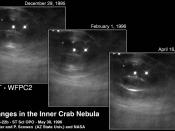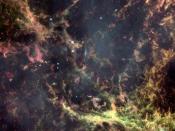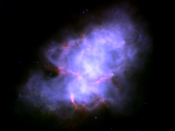Exploring the Crab Nebula
In 5466 BC in the constellation of Taurus, the last weeks of a stars life were drawing too close. Having a mass of at least 8 times that of our Sun during its main sequence life, this star's death resulted in a magnificent supernova. Yet, it wouldn't be until about 6,500 years later that the first photons from the explosion would begin reaching Earth. This describes simply a taste of the processes that led to both the creation and discovery of the intriguing Crab Nebula that is found within the cosmos today.
The Crab Nebula is the most famous supernova remnant. Supernovae occur when a high mass star (a star with mass greater than approximately 8 solar masses) collapses at the end of its life. With this collapse, an enormous shock wave sweeps through the star at high speed, blasting away the various layers into space, leaving a neutron core, and an expanding shell of matter known as a supernova remnant.
On a summer night in imperial China in the year 1054, court astrologers observed a new mark in the heavens that beckoned between the horns of the constellation that we call the Bull. Not only did this new star out blaze the others, but also it was brighter than even the planets Jupiter and Venus. "On August 27 the distinguished astrologer Yang Wei-te reports thus to the anxious emperor, "Prostrating myself before your Majesty I hereby report that a guest star has appeared; above the star in question there is a faint glow, yellow in color. If one carefully examines the prognostications concerning the emperor, the interpretation is as follows: The fact that the guest star does not trespass against Pi the lunar mansion in Taurus and its brightness is full means that there is...


